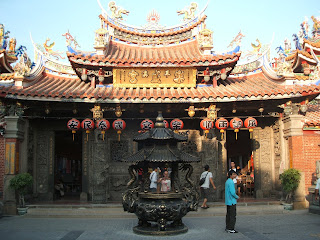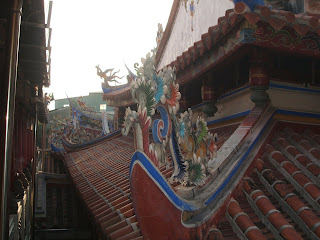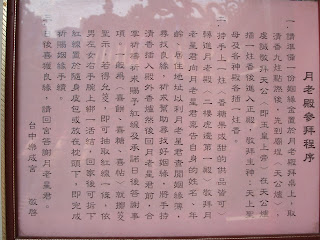 According to the historical information, in 1753, a Lin family arrived at here from the mainland. To pray for a peaceful life and the security of the family, they took a sculpture of Matsu(媽祖) with them, and called here "Matsu of Hanshi"(旱溪媽祖).
According to the historical information, in 1753, a Lin family arrived at here from the mainland. To pray for a peaceful life and the security of the family, they took a sculpture of Matsu(媽祖) with them, and called here "Matsu of Hanshi"(旱溪媽祖). Many legends of Great Taichung, especially the event that Matsu helped the people in "eighteen village"(十八庄) eliminated a sea of dangerous insects and turtles, which has been passed down to this time. Until now, in every eleventh of March of Chinese Lunar calendar, they held "Surrounding the eighteen villages march"(繞十八庄繞境活動). People in eighteen village express their most pious worship to Matsu and Matsu also blessed them in return with rich harvest and peaceful life. Therefore, Lecheng Temple has been a religious center of this area. After two large expansion in 1920s and 1980s, it became the style that we could see now. In the terrible earthquake in September 21th, 1999, Lecheng Temple suffered a serious damage.
Many legends of Great Taichung, especially the event that Matsu helped the people in "eighteen village"(十八庄) eliminated a sea of dangerous insects and turtles, which has been passed down to this time. Until now, in every eleventh of March of Chinese Lunar calendar, they held "Surrounding the eighteen villages march"(繞十八庄繞境活動). People in eighteen village express their most pious worship to Matsu and Matsu also blessed them in return with rich harvest and peaceful life. Therefore, Lecheng Temple has been a religious center of this area. After two large expansion in 1920s and 1980s, it became the style that we could see now. In the terrible earthquake in September 21th, 1999, Lecheng Temple suffered a serious damage.After being repaired for several years, what it's like was what it used to be. According to the build, repair and extansion, it is like a symbol of development of the Great Taichung.
 The temple has a big scale and various kinds of decorations. For example, the Ching-tou Stone Lions (青斗石獅), the stone column with dragon pattens (雕龍畫柱) and the sculptures made from Chiao-Chin-clay (交趾陶) were the unique features of this temple.
The temple has a big scale and various kinds of decorations. For example, the Ching-tou Stone Lions (青斗石獅), the stone column with dragon pattens (雕龍畫柱) and the sculptures made from Chiao-Chin-clay (交趾陶) were the unique features of this temple.

 Different from the Matsu Temple. there were also many Gods worshipped here: Matsu, Jade Emperor(玉皇大帝), Guan Yin(觀世音菩薩), Xuan Wu(觀音), Guan Yu(關羽), Cai Shen(財神), Songzi Niangniang (註生娘娘), Wenchang(文昌), The Old Man under the Moon(月老), Hua Tuo(華陀),and etc.
Different from the Matsu Temple. there were also many Gods worshipped here: Matsu, Jade Emperor(玉皇大帝), Guan Yin(觀世音菩薩), Xuan Wu(觀音), Guan Yu(關羽), Cai Shen(財神), Songzi Niangniang (註生娘娘), Wenchang(文昌), The Old Man under the Moon(月老), Hua Tuo(華陀),and etc.








After I see your photo, I want to draw lots, too. I am also familiar with the march of Matsu that you mention because everytime I always meet the group at my hometown. It's interesting to read your article because it always reminds me of my childhood.
回覆刪除It's fun to know many activities in the Lecheng Temple. I haven't seen the march of Matsu yet, but i know it is very serious and it's a big event to her followers.
回覆刪除